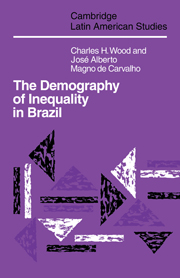Book contents
- Frontmatter
- Contents
- Illustrations
- List of tables
- Preface
- 1 Introduction
- 2 Framework for the study of population, development and inequality
- 3 Growth and distribution in historical perspective
- 4 Income inequality and length of life
- 5 Wage policy, infant mortality and collective social action in São Paulo
- 6 Racial inequality and child mortality
- 7 The “baby bust”
- 8 Income distribution and population growth
- 9 Agrarian structure and the rural exodus
- 10 Colonization and frontier expansion in Amazônia
- 11 Development and persistent underemployment
- 12 The demography of inequality in Brazil: summary and conclusion
- Appendix: A note on method
- Notes
- Bibliography
- Index
- CAMBRIDGE LATIN AMERICAN STUDIES
8 - Income distribution and population growth
Published online by Cambridge University Press: 04 August 2010
- Frontmatter
- Contents
- Illustrations
- List of tables
- Preface
- 1 Introduction
- 2 Framework for the study of population, development and inequality
- 3 Growth and distribution in historical perspective
- 4 Income inequality and length of life
- 5 Wage policy, infant mortality and collective social action in São Paulo
- 6 Racial inequality and child mortality
- 7 The “baby bust”
- 8 Income distribution and population growth
- 9 Agrarian structure and the rural exodus
- 10 Colonization and frontier expansion in Amazônia
- 11 Development and persistent underemployment
- 12 The demography of inequality in Brazil: summary and conclusion
- Appendix: A note on method
- Notes
- Bibliography
- Index
- CAMBRIDGE LATIN AMERICAN STUDIES
Summary
Contrary to theories of development popular in the post-World War II period, data for developing countries (Chenery et al. 1974; Adelman and Morris 1973; Weiskoff and Figueroa 1976) showed that the process of economic growth did not necessarily lead to a more equitable distribution of income. In some cases, such as in Brazil in the late 1960s and early 1970s, high rates of increase in Gross Domestic Product were associated with a rise rather than a decline in the degree of income concentration.
In light of the socioeconomic and political significance of changes in the distribution of income, researchers devoted considerable effort to measuring and explaining the degree of income concentration (see chapter 3). Among the causal variables singled out, few have been subjected to less systematic analysis than population growth. Most analyses in the field of development studies seldom go beyond the general assertion that a low rate of population increase contributes to a more equitable distribution of income (Ghai 1975: 506). At times the observation amounted to little more than an article of faith. A World Bank Staff Report, for example, concluded that “there appears to be no explicit dissent from the view that lower fertility contributes to greater income equality” (King et al. 1974: 35). In Cassen's (1976: 812) view, the state of the literature is a “sad reflection” on the separation of demographic and economic studies and the prolonged debate on “growth versus distribution” has largely overlooked the feedback of demographic change.
- Type
- Chapter
- Information
- The Demography of Inequality in Brazil , pp. 184 - 200Publisher: Cambridge University PressPrint publication year: 1988



